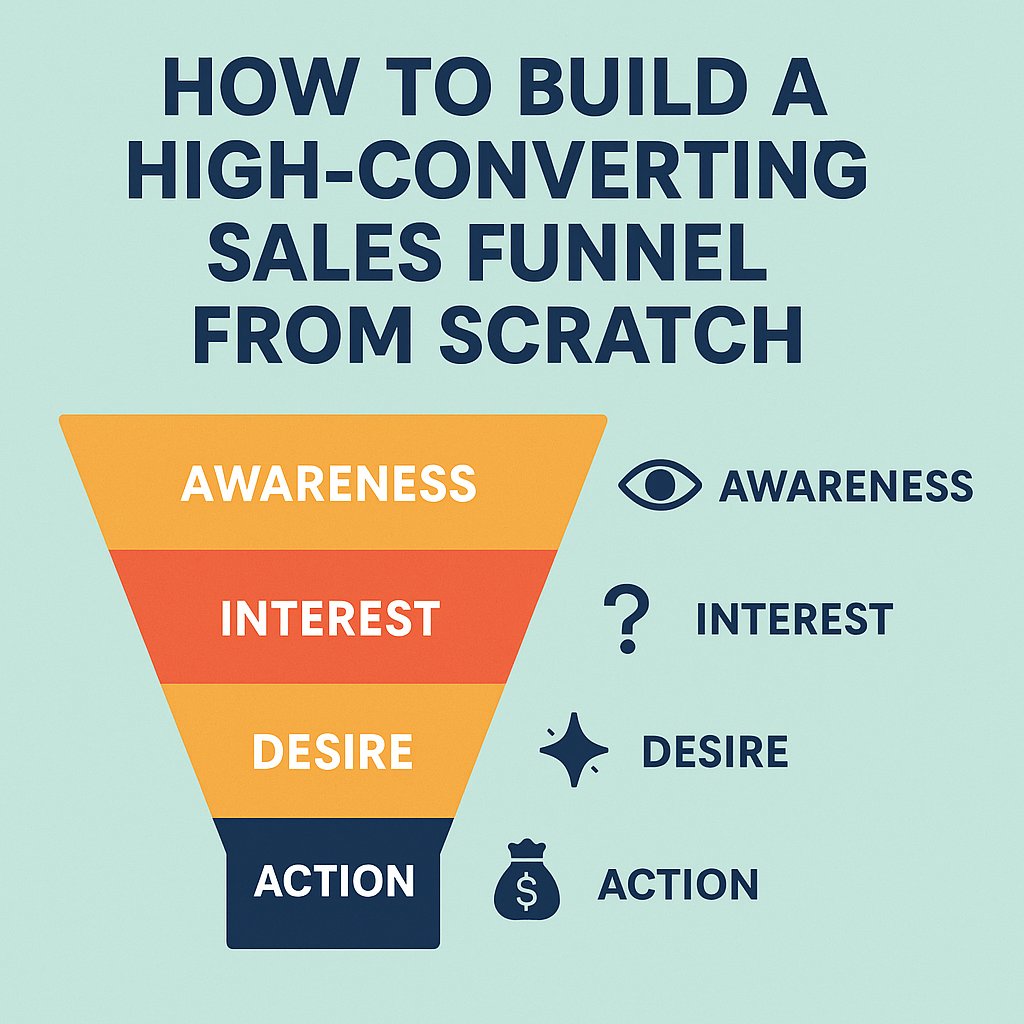In today’s digital world, if your business isn’t using a sales funnel, you’re leaving money on the table—period. Whether you’re selling a course, affiliate product, service, or digital download, a high-converting funnel is your 24/7 sales machine. But where do you start if you’re new to marketing?
In this step-by-step guide, I’ll break down how to build a sales funnel from scratch, even if you’re a complete beginner. No fluff, just actionable advice you can implement today.
What is a Sales Funnel?
A sales funnel is the step-by-step process that guides your audience from a stranger to a paying customer. Imagine it like this:
👀 Awareness → 🤔 Interest → ✨ Desire → 💸 Action
Each step in the funnel is designed to remove objections and build trust, so by the time someone hits “Buy Now,” it feels like a no-brainer.
Why Sales Funnels Work
Here’s why funnels are so effective:
-
They automate your sales process.
-
They segment and nurture cold leads into warm buyers.
-
They can generate income 24/7, even while you sleep.
-
They’re measurable—you can see what’s working and improve it.
Whether you’re selling coaching, affiliate products, or services, a good funnel multiplies your efforts.
Tools You’ll Need
You don’t need a tech degree to set this up. Just use plug-and-play tools like:
-
Systeme.io – All-in-one funnel builder (free to start!)
-
ConvertKit or GetResponse – Email marketing
-
Canva – To design your lead magnet or landing page graphics
-
Google Analytics – For tracking performance
Step 1: Define Your Offer
Start with what you’re selling. This could be:
-
A course
-
A digital product
-
An affiliate offer
-
A service (like coaching or consulting)
What problem does it solve? Why should someone buy it from YOU?
Example: If you’re selling a course on TikTok growth, your offer could be:
“Learn how to grow your TikTok to 10,000 followers in 30 days—even if you’re starting from zero.”
Step 2: Know Your Audience
If your funnel doesn’t speak to a specific person with a specific problem, it won’t convert.
Ask yourself:
-
Who is my ideal customer?
-
What’s their biggest pain point?
-
What’s their dream outcome?
Use tools like Google Trends, Reddit, or AnswerThePublic to dig into what they’re searching for.
Step 3: Create a Lead Magnet
A lead magnet is a free, irresistible offer in exchange for someone’s email address.
🎁 Great lead magnet ideas:
-
Free checklist
-
Ebook or guide
-
Webinar
-
Email course
-
Template or swipe file
Example: “Download my 7-Point Funnel Checklist That Converts Cold Traffic Into Sales!”
Step 4: Build a Landing Page
Your landing page should be focused on ONE thing—getting your visitor to opt-in or buy.
🔥 Must-have elements:
-
A powerful headline
-
Benefits-focused copy
-
A visual of the lead magnet or product
-
A clear call-to-action (CTA)
-
Social proof (testimonials or logos)
-
Mobile-optimized layout
Use a tool like Systeme.io or Leadpages to build this in minutes.
Step 5: Set Up an Email Automation Sequence
Once someone opts in, don’t ghost them!
Set up an automated email sequence to:
-
Welcome them.
-
Deliver value and introduce yourself.
-
Share success stories or results.
-
Pitch your offer after trust is built.
💡Tip: Use 3–5 emails over a few days before asking for the sale.
Step 6: Drive Traffic to Your Funnel
You’ve built the funnel—now get people into it!
📣 Traffic Sources:
-
Organic: SEO blog posts, YouTube, Instagram, TikTok
-
Paid: Facebook ads, Google ads, solo email ads
-
Partnered: Affiliate partners or influencers
If you’re a beginner, start with organic or low-budget paid traffic.
Step 7: Track, Test & Optimize
Use tools like Google Analytics, Facebook Pixel, or Hotjar to monitor:
-
Conversion rates
-
Drop-off points
-
Email open/click rates
-
Funnel ROI
Tweak headlines, CTAs, and email subject lines based on the data.
Funnel Mistakes Beginners Make (and How to Avoid Them)
❌ Too many CTAs – Keep it focused.
❌ No follow-up – Always nurture leads.
❌ Skipping audience research – Know their pain points.
❌ Poor mobile design – Most visitors are on phones.
❌ Expecting instant results – Funnels take testing!
A well-built sales funnel isn’t just a marketing trick—it’s the foundation of a scalable online business. If you’re just getting started, don’t overcomplicate it.
Follow these steps. Start small. Keep improving. And most importantly—take action.
Your first funnel won’t be perfect, but it’ll teach you more than any course ever could.
FAQs
Q1: Do I need a funnel for affiliate marketing?
Yes! Even if you’re promoting someone else’s product, a funnel helps you capture leads, warm them up, and increase conversions.
Q2: What’s the best free funnel builder for beginners?
Systeme.io is a top choice—easy to use, all-in-one, and has a solid free plan.
Q3: How many emails should my automation have?
Start with 3–5 emails. Focus on building trust before pitching your main offer.
Q4: Can I build a funnel without a website?
Yes. Funnel builders like Systeme.io let you create landing pages without a full website.
Q5: How long does it take to build a sales funnel?
You can build a basic funnel in 1–2 days. The key is refining it over time as you get data.



Leave A Comment